

The diversity of plant genetic resources for food and agriculture was under growing threat as despite 6,000 plant species cultivated, 60 per cent of the global crop production was alarmingly dependent on just nine crops, an important report by the United Nations Food and Agriculture Organization (FAO) revealed on March 24.
These nine crops were sugarcane, maize, rice, wheat, potatoes, soybeans, oil palm fruit, sugar beet, and cassava.
The Third Report on the State of the World’s Plant Genetic Resources for Food and Agriculture (SoW3) was based primarily on information provided by 128 countries and four regional and 13 international research centres.
Published by FAO, the report, through surveys of farmers’ varieties/landraces (FV/LR), found an average of 6 per cent of their diversity threatened globally. Of the 18 sub-regions surveyed, diversity in nine was more alarming with 18 per cent or more of FV/LR reported as threatened.
The highest percentage of threatened diversity was found in southern Africa, followed by the Caribbean and Western Asia. Southern Asia, along with Australia and New Zealand had the least threatened diversity of farmers’ varieties and landraces.
The report also showed that during the reporting period (2011-2022), approximately 35 million hectares in 51 countries — equivalent to 44 per cent of the total crop area of reported sites within areas of high diversity — were cultivated with FV/LR.
Talking about the state of in-situ (on-farm) conservation, the report mentioned that approximately 42 per cent of surveyed taxa (grouping of plant species) were reported to be threatened at either the species or varietal levels.
In India too, conservation interventions were required to prevent large-scale genetic on-farm erosion as the study highlighted that more than 50 per cent of documented FV/LRs across five agroecological zones were considered as threatened.
Meanwhile, in terms of ex situ conservation, despite advances made over the past 10 years, it was found that many issues that impede the efficient and effective conservation of PGRFA still remain and need to be addressed.
“Ex situ conservation still lacks the necessary political and financial support in many countries, which often results in limited or sporadic funding, lack of sufficiently qualified staff, and insufficient infrastructure and logistics,” it said.
The report also noted the contribution of Indian agriculture ministry’s project of ‘creation of seed hubs for increasing indigenous production of pulses’ initiated in 2016 towards greater availability of quality seeds of new (less than 10-year-old) high-yielding varieties (HYVs) of pulse crops to smallholder farmers. This project led to an increase in pulse production from 14.76 million tonnes in 2007 and 2008 to 24.42 million tonnes in 2020 and 2021.
Even as the frequency and severity of erratic extreme weather events has been on the rise, the report noted that many countries reported a gap in assessing the impacts of disasters on crop diversity.
“While impacts on the agricultural sector after emergencies are often estimated in terms of monetary and nutrition costs, many countries reported a gap in assessing the impacts of disasters on crop diversity. Additional challenges are the identification of reliable sources of materials and the fact that the germplasm distributed to farmers after disaster situations may not always be fully adapted to the local conditions or the cultural environment,” it said.